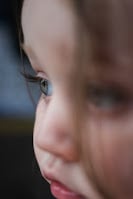Eye Tracking May Aid Diagnosis of Autism in Young Children, Study Suggests

An eye-tracking device that measures social-visual engagement (how children look and learn from their surrounding social environment) may help to predict autism in children at risk for the disorder, according to a report in JAMA.
“Most parents of children with autism report having had concerns before the second birthday, yet the median age of U.S. autism diagnosis is 4 to 5 years,” wrote Warren Jones, Ph.D., of the Marcus Autism Center in Atlanta and colleagues. Objective biomarker tests could help reduce diagnostic delays and connect young people with services earlier.
For the study, Jones and colleagues recruited 475 children aged 16 to 30 months old who were enrolled at six U.S. autism specialty centers between April 2018 and May 2019. The cohort included a broad spectrum of children with autism—both with and without co-occurring intellectual and developmental delays—as well as many children without autism who nonetheless had significant speech-language and other developmental disabilities.
All participants were evaluated by autism experts who relied on such standardized assessments as the Autism Diagnostic Observation Schedule, Second Edition; the Mullen Scales of Early Learning; and DSM-5 criteria. In addition, clinical site staff used an automated device to track the children’s eye movement as they watched short videos of social interaction (for example, children playing together). Those performing the eye-tracking tests and clinical assessments were blind to each other’s results.
Eye-tracking of social-visual engagement was highly sensitive, successfully identifying children who were diagnosed with autism by clinical assessment in 71% of cases. The technique was also highly specific, correctly identifying those children who would not be diagnosed with autism in nearly 81% percent of cases. The eye-tracking test results correlated with clinical assessments of the child’s level of autism-related behaviors and verbal and cognitive abilities.
In an accompanying editorial, Geraldine Dawson, Ph.D., of the Duke University Center for Autism and Brain Development said the study “represents a significant step forward toward developing more objective tools for early diagnosis of autism.” She added, “Another possible future application of the findings … is the use of eye tracking to identify infants younger than 1 year who have a higher likelihood of a later autism diagnosis.”
Dawson said that demonstrating that an eye-tracking test improves diagnostic certainty would require following children whose diagnosis was uncertain to determine whether the test improves prediction of a later definitive autism diagnosis. “Future studies will need to assess how feasible, acceptable, reliable, and efficient the eye-tracking test is when used by clinicians as an aid in autism diagnosis in practice,” she wrote.
For related information, see the Psychiatric News article “Visual Diagnostics Become More Accessible.”
(Image: iStock/shaunl)
Don't miss out! To learn about newly posted articles in Psychiatric News, please sign up here.






